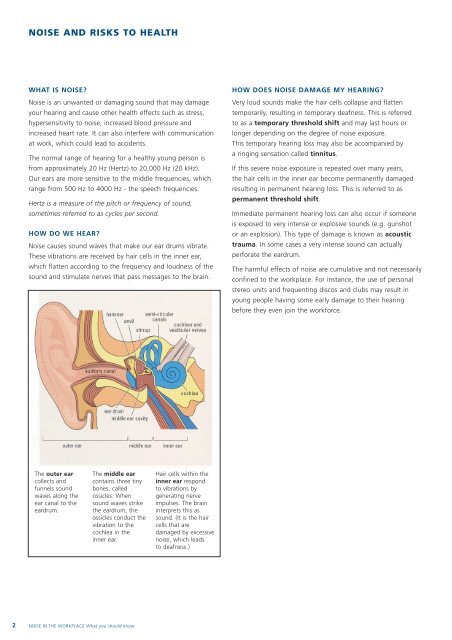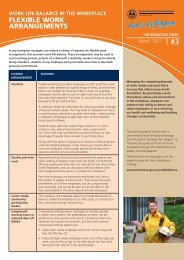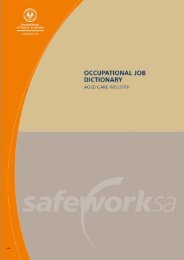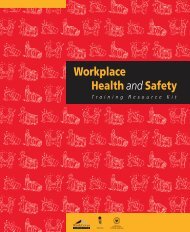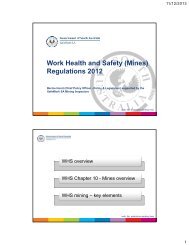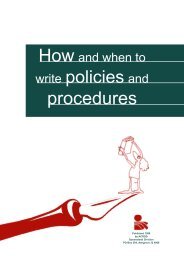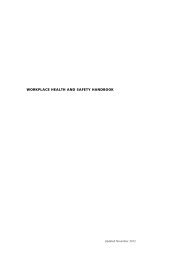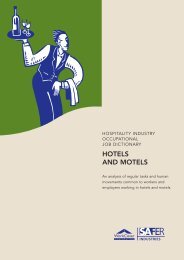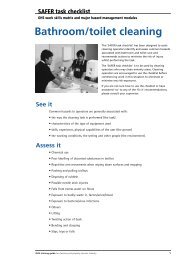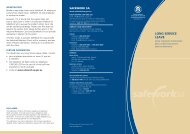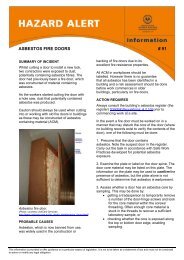NOISE IN THE WORKPLACE - SafeWork SA
NOISE IN THE WORKPLACE - SafeWork SA
NOISE IN THE WORKPLACE - SafeWork SA
You also want an ePaper? Increase the reach of your titles
YUMPU automatically turns print PDFs into web optimized ePapers that Google loves.
2<br />
<strong>NOISE</strong> AND RISKS TO HEALTH<br />
WHAT IS <strong>NOISE</strong>?<br />
Noise is an unwanted or damaging sound that may damage<br />
your hearing and cause other health effects such as stress,<br />
hypersensitivity to noise, increased blood pressure and<br />
increased heart rate. It can also interfere with communication<br />
at work, which could lead to accidents.<br />
The normal range of hearing for a healthy young person is<br />
from approximately 20 Hz (Hertz) to 20,000 Hz (20 kHz).<br />
Our ears are more sensitive to the middle frequencies, which<br />
range from 500 Hz to 4000 Hz - the speech frequencies.<br />
Hertz is a measure of the pitch or frequency of sound,<br />
sometimes referred to as cycles per second.<br />
HOW DO WE HEAR?<br />
Noise causes sound waves that make our ear drums vibrate.<br />
These vibrations are received by hair cells in the inner ear,<br />
which flatten according to the frequency and loudness of the<br />
sound and stimulate nerves that pass messages to the brain.<br />
The outer ear<br />
collects and<br />
funnels sound<br />
waves along the<br />
ear canal to the<br />
eardrum.<br />
The middle ear<br />
contains three tiny<br />
bones, called<br />
ossicles. When<br />
sound waves strike<br />
the eardrum, the<br />
ossicles conduct the<br />
vibration to the<br />
cochlea in the<br />
inner ear.<br />
<strong>NOISE</strong> <strong>IN</strong> <strong>THE</strong> <strong>WORKPLACE</strong> What you should know<br />
Hair cells within the<br />
inner ear respond<br />
to vibrations by<br />
generating nerve<br />
impulses. The brain<br />
interprets this as<br />
sound. (It is the hair<br />
cells that are<br />
damaged by excessive<br />
noise, which leads<br />
to deafness.)<br />
HOW DOES <strong>NOISE</strong> DAMAGE MY HEAR<strong>IN</strong>G?<br />
Very loud sounds make the hair cells collapse and flatten<br />
temporarily, resulting in temporary deafness. This is referred<br />
to as a temporary threshold shift and may last hours or<br />
longer depending on the degree of noise exposure.<br />
This temporary hearing loss may also be accompanied by<br />
a ringing sensation called tinnitus.<br />
If this severe noise exposure is repeated over many years,<br />
the hair cells in the inner ear become permanently damaged<br />
resulting in permanent hearing loss. This is referred to as<br />
permanent threshold shift.<br />
Immediate permanent hearing loss can also occur if someone<br />
is exposed to very intense or explosive sounds (e.g. gunshot<br />
or an explosion). This type of damage is known as acoustic<br />
trauma. In some cases a very intense sound can actually<br />
perforate the eardrum.<br />
The harmful effects of noise are cumulative and not necessarily<br />
confined to the workplace. For instance, the use of personal<br />
stereo units and frequenting discos and clubs may result in<br />
young people having some early damage to their hearing<br />
before they even join the workforce.


